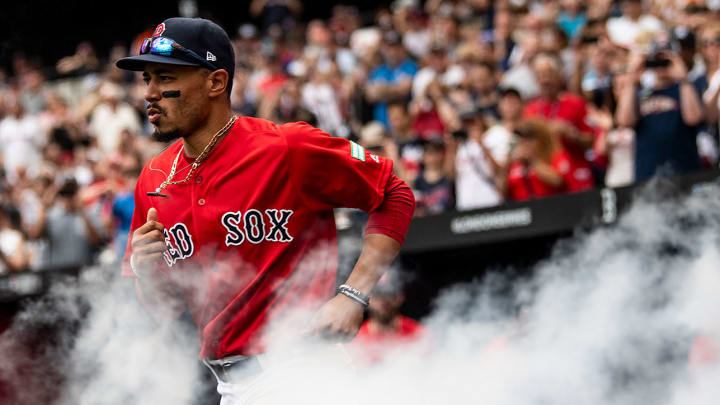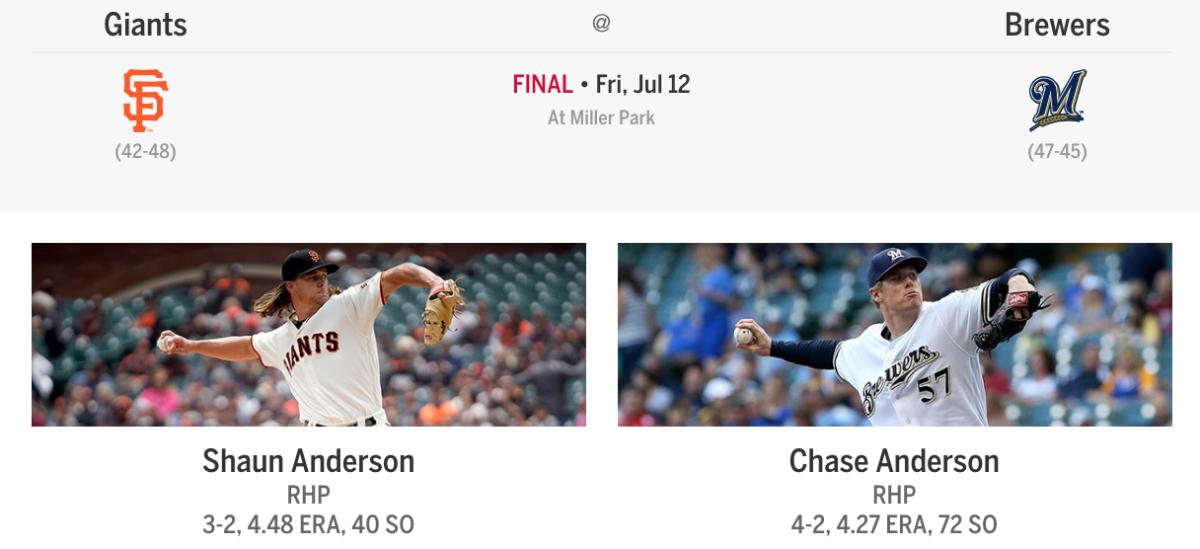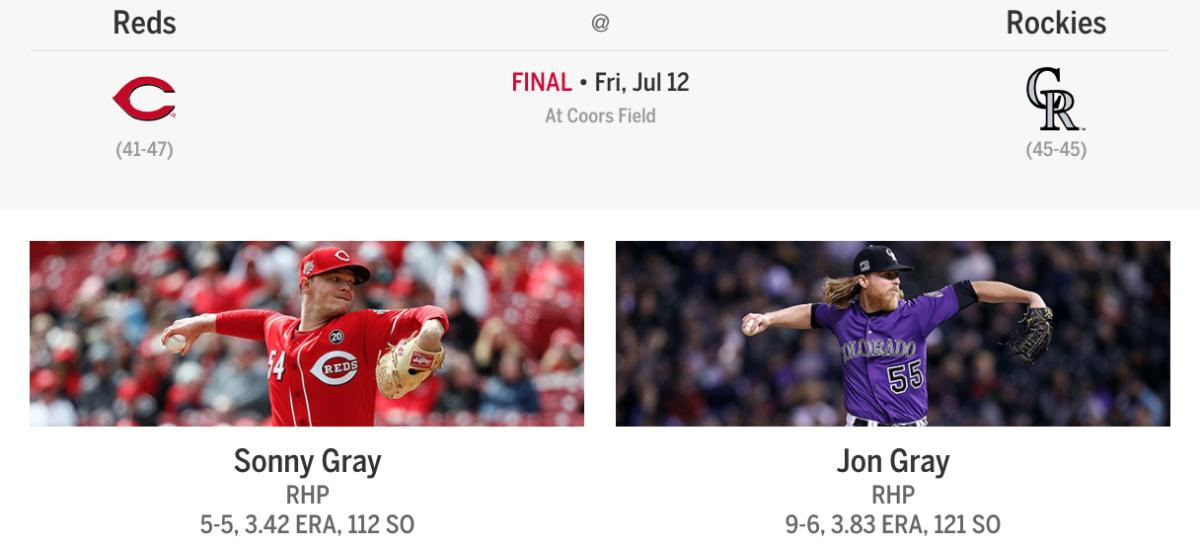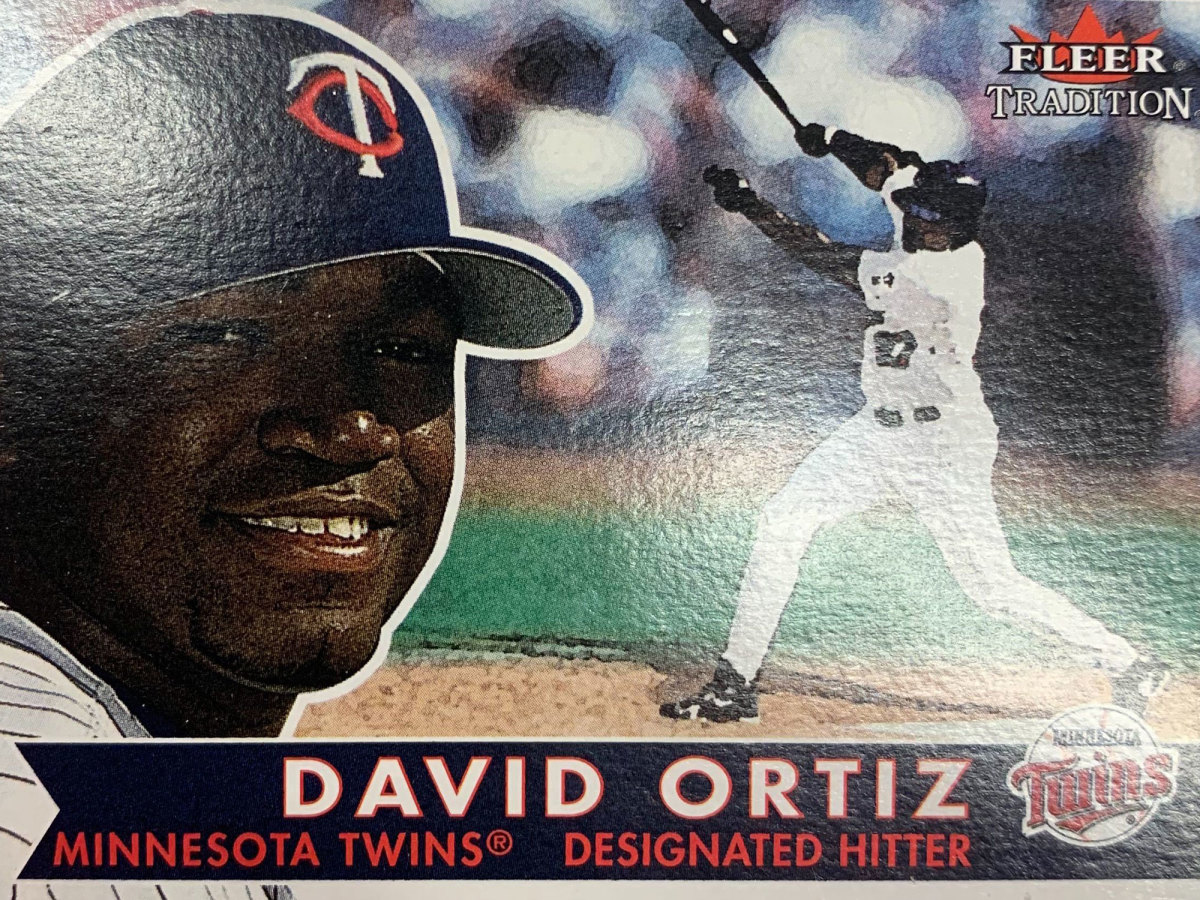Why Isn't Mookie Betts a Household Name? It's Complicated

Welcome back to Nine Innings, SI’s weekly look at what’s fun, cool and somewhat stupid around the league. Today’s topics include: Making Mookie the next Messi, Vlad Jr.’s awe-inspiring Derby, Giannis sucking at baseball, and much more.
If you have any feedback, questions or angry rants to send my way, hit me up via email (jon.tayler@simail.com) or Twitter.
This Week In … Marketing Mookie!
Mookie Betts should be a marketing department’s dream. He’s young and handsome. He’s an MVP, a world champion and a four-time All-Star. He’s the main attraction on a historic franchise that’s one of the game’s biggest draws. He’s even a top-flight bowler. Mookie should be one of MLB’s main selling points.
At least, that’s how MLB Players Association president Tony Clark sees things. Per Julian McWilliams in the Boston Globe last Wednesday:
“Mookie should be a household name,” Clark said. “Mookie should be a one-name guy. You say [Cristiano] Ronaldo. You say [Lionel] Messi. You say Mookie. You should know who Mookie is. And outside the baseball world I don’t know how many people do.”
Clark is right about the last part. It’s a good bet that most outside the sport have never heard of Betts. Few if any current players meet that criteria; I’d wager more people on the street would name Derek Jeter if asked to come up with a major leaguer than anyone else—save perhaps Bryce Harper. Cody Bellinger leads the league with 33 home runs; showing his photo to non-baseball fans would draw blank stares. Max Scherzer is the greatest pitcher on earth, but he and his different-colored eyes might as well be made up when it comes to people who don’t watch baseball regularly. Mike Trout will go down as one of the five best players in history, and he’s about as anonymous as a future Hall of Famer can get.
Every sport wrestles to some degree with player awareness—for all of Clark’s complaints, at least he’s not tasked with making the NHL a household league—but MLB can’t quite crack the level that the NFL and NBA already have. The stars in those leagues are the kind of one-word monikers Clark dreams about: LeBron, Brady, Steph, OBJ. Through endorsement deals and partnerships (and their own superlative talent), those players have become omnipresent. That reaches an even bigger level with men like Ronaldo or Messi in the international world of professional soccer. These are more than just players; they’re practically brands unto themselves.
But is that kind of penetration even possible with baseball? The game’s national heyday is decades in the past. Football is the most watched sport in America; basketball isn’t far behind. That’s not to invoke the old trope that baseball is dying—only that it’s in third place, and sometimes fourth in the fall, depending on the college football matchups. By extension, its stars won’t shine as bright.
Good looks, @mookiebetts. 🔥 pic.twitter.com/8Rd0OCRfc9
— MLB (@MLB) July 9, 2019
The trick of how to market baseball is one without an easy answer. MLB seems to have settled on a strategy of playing up the game’s youth, invoking a collective generational upswing instead of a Ken Griffey Jr.-style focus on one man and his superhuman abilities (with Trout as the occasional exception). To that end, McWilliams notes that an MLB source told him Betts declined to participate in the league’s “Let The Kids Play” ad campaign. He also brought up this interesting nugget: “Some players around the league have expressed their displeasure with how MLB promotes them. From being mic’d up … to appearing in MLB commercials, the players are only generating revenue for a $10 billion-plus business.”
MLB is using its players to raise MLB awareness; Clark and the PA want players to become their own masters. That’s an unsurprising divide and result: The league isn’t interested in empowering players to earn more money, but just to sell the product that is baseball. MLB’s other big marketing push that happens in October around the playoffs is similar, centered on the collective glory of winning and the gauntlet that is the postseason, not on the individuals whose arms and legs carry teams to titles.
LET. THE. KIDS. PLAY. pic.twitter.com/BkfOaSmt7g
— MLB (@MLB) April 3, 2019
Ultimately, Clark’s dreams of a world where Betts is invoked in the same breath as Ronaldo and Messi are hard to turn into reality. Even with all the marketing push in the world, he’ll never reach that level; the best bet for who could is Harper. But since baseball players can’t control the spotlight the same way their NFL and NBA counterparts can, given their inability to swing a team’s fortunes alone, this level may be the best anyone can hope for.
But if so, does that doom baseball? If your average Joe doesn’t know who Mike Trout is, will the sport wither and die? There might never be another Griffey or Jeter in terms of someone who can draw casual, worldwide interest, and that’s okay. Baseball will survive without it. The question at that point becomes who profits the most.
This Week In … Vladimir Guerrero Jr.!
It was magical, wasn’t it? Guerrero’s nuclear fireworks display of a Home Run Derby was breathtaking, like something out of a video game with all the settings turned to maximum stupid. Between the distance and the speed and the six-hour round against Joc Pederson, it delivered on every single promise. Mouth agape, jaw on the floor, every hair standing up … that was the feeling watching Vlad Jr. out-do the Derby legends of Ken Griffey Jr. and Josh Hamilton and Giancarlo Stanton by murdering nearly a hundred baseballs. And there was no art or beauty to it either; this spray chart is pure, weapons-grade violence.
29 home runs for Vlad Jr!!!!!!! Yep I’m a fan. Record breaker!!!! #AllStarGame2019 #HomeRunDerby pic.twitter.com/pQqlAc95J9
— Taylor Twellman (@TaylorTwellman) July 9, 2019
Anyway, my words are a waste, because they can’t capture in any sense the titanic majesty of Guerrero laying down artillery fire for three straight hours. So instead, go bask in this recap of his night one more time—and yes, above is a 21-minute highlight video, and I wish it were three times as long and also set to “The 1812 Overture.”
Long live Vlad.
This Week In … Sticking With Your Day Job!
Giannis Antetokounmpo is really good at basketball. That should be obvious, given he’s the reigning NBA MVP and is built like someone crossbred an NFL linebacker with a Slinky and gave him Mickey Mouse’s hands. (Seriously, check out this photo of him gripping a baseball and making it look like it’s a grape.) It turns out, though, that being a basketball superstar doesn’t translate over to baseball. To wit: this absolutely garbage attempt at hitting on Monday when the Greek Freak made a trip to the Bronx to hang out with the Yankees (and make CC Sabathia somehow look small).
Alley-Oops. @Giannis_An34 pic.twitter.com/0YTCSTvXQm
— New York Yankees (@Yankees) July 15, 2019
Okay, maybe “absolutely garbage” is a little too strong. Giannis does make decent contact twice despite gripping the bat like it’s covered in oil and about to bite him, and a stance that’s as stiff as petrified wood. But he’s definitely no threat to pull a Michael Jordan on us and ditch the hardwood for the diamond. If he does, though, I demand the Yankees sign him so that we can get endless photos of him standing next to Aaron Judge (or conversely, that he joins the Astros and then always hangs out with Jose Altuve).
This Week In … Inconvenient Truths!
The Rockies got blasted by the Giants in the first game of a doubleheader on Monday—like, dipped in napalm and thrown into a gasoline fire levels of destroyed. San Francisco scored five runs in the first inning and another seven in the third and ended up winning 19–2. It was an effort so lopsided that the Rockies’ broadcast decided, in the bottom of the fourth, that no one needed to know just how bad it had gotten.
“I have control,” says color commentator Ryan Spillborghs as he scratches out the score. It’s too bad for Colorado that he and the rest of the TV folks couldn’t actually fix things in real life.
This Week In … Ignoring the Man!
Nicholas Castellanos’s days with the Tigers are numbered, given that he’s a free agent at season’s end and Detroit is going nowhere this year. But he clearly wants to make every last moment he gets in a Tigers uniform count, even if the moment itself doesn’t.
Here's a reminder that neither Nick Goody nor Nicholas Castellanos wanted a rain delay ... pic.twitter.com/fkNF0vDdnI
— Cleveland Guardians (@CleGuardians) July 16, 2019
That’s him and the Indians’ Nick Goody refusing to let a rain delay get in the way of an at-bat in progress. It’s a nice moment reminiscent of two kids desperate to keep playing no matter what happens. It’s also a reflection on Castellanos’ part that, hey, he’s up 3–0 in the count, don’t take that away from him.
This Week In … Attack of the Clones!
Last Friday, viewers of Giants-Brewers got treated to a matchup of equals, so to speak.

So did viewers of Rockies-Reds.

Yep, that’s two separate matchups of guys with the same last name on the same day—an unprecedented combo of confusing coincidences. And while it’s not the first time this year MLB has seen that kind of matchup—the Royals’ Jorge Lopez and the White Sox’ Reynaldo Lopez squared off back on April 16, then again on May 29, albeit with Jorge entering that game in relief—it’s definitely the first time this season it’s happened twice on the same day.
So how did it shake out? Well, in Milwaukee, Anderson got the better of Anderson, and in Colorado, Gray topped Gray. Pretty straightforward.
This Week In … Going Out With A Bang
If you don’t know the name Cody Decker, that’s understandable. The 32-year-old first baseman has appeared in just eight MLB games, all coming way back in 2015. Instead, the majority of his professional career has been spent in the minors—over 1,000 games across 11 seasons. (He also had a memorable stint on the 2017 Israel World Baseball Classic team.) In that time, though, Decker has hit 204 home runs, the most of any active player in the minors—and that last one ended up being truly special.
That two-run bomb to help Triple-A Reno beat Sacramento, 10–9, back on July 7 wasn’t just a walk-off for Decker; it was also the last homer of his career. After the game, he announced that he was calling it quits and leaving the world of minor league baseball behind. It’s a hell of a way to go out.
This Week In … Losing Track of Time!
Max Scherzer is as close to perfect as a baseball player can get. (For proof: his month of June, in which he allowed just five runs in 45 innings and struck out 68 hitters.) But even the all-time greats slip up every now and again. In Scherzer’s case, it wasn’t on the mound, but in simply remembering the literal game situation, as you can see in this clip from July 7, when he bounds out of the dugout to high five Adam Eaton for scoring what he thought was the game-ending run—in the eighth inning.
In Scherzer’s defense, Eaton came across on an Anthony Rendon RBI double to break a 2–2 tie, so it’s easy to understand why he thought it was a walk-off win. Then again, the simpler explanation here is the one in character for Scherzer: His competitiveness simply wouldn’t let him be the last one out of the dugout in any celebration circumstance. This is a man who pitched with a broken nose and a black eye that was the result of trying to bunt a ball at a coach. No way was anyone going to beat Scherzer to any potential congratulatory butt slap.

This Week In … Old Baseball Cards!
Each week, I’ll pluck a random baseball card out of a pile of old 1980s, 90s and 2000s cards I have at my work desk, then write a quick little take on the player in question. This week’s entry: David Ortiz, 1B, Twins (Fleer 2001)
The sum total of David Ortiz’s Twins career was six seasons, 455 games, 58 homers, and one of the biggest “What If” conundrums in baseball history. The man formerly known as David Arias came to Minnesota from Seattle in exchange for veteran infielder Dave Hollins, but he never became a big part of the Twins’ plans. In 1997, ’98 and ’99, he was a part-time player; in that last campaign, his entire contribution was 10 games, all coming in September, as grizzled manager Tom Kelly instead gave time at first base and designated hitter to Doug Mientkiewicz (OPS+: 66), Ron Coomer (82) and Marty Cordova (108).
That the Twins decided these were better options than a young slugger who had hit well the year prior is a reminder that baseball was still somewhat stuck in the Dark Ages even in the late 1990s. For the most part, things 20 years ago operated in a simple fashion: You either impressed someone or you didn’t, and Ortiz couldn’t break through with Kelly.
“I don’t think he really liked me,” Ortiz said of his skipper to the Boston Globe’s Nick Cafardo back in 2015. “I don’t know why. He was hard on young players. He was the kind of manager who liked veteran players. He never liked me.”
That was to the Twins’ endless chagrin: After the 2003 season, Ortiz was released to save money and scooped up by the Red Sox on the recommendation of Pedro Martinez and longtime international scout Louis Eljaua. Boston already had Jeremy Giambi, Shea Hillenbrand and Kevin Millar in the fold, but Ortiz broke through that crowded group to become the regular DH, establishing himself as a fixture, icon and superstar.
Still, it took years, and two separate teams looking at Ortiz and seeing nothing, and a lot of luck and good timing with the third for something to happen at all. Maybe better stats and science or a less old-school manager would’ve discovered Ortiz sooner. All we can wonder now is, “What if?”
